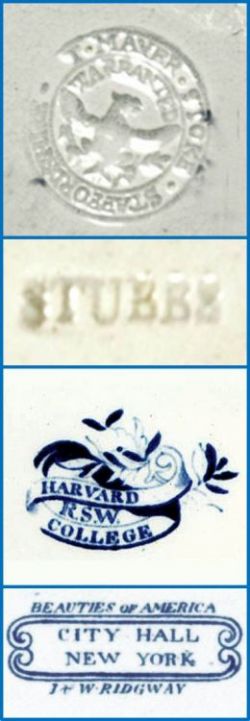Marks by MakerThere are many kinds of marks found on pottery, usually on the base or reverse. On dark blue printed American-themed patterns, there are impressed and printed marks. In most cases, the maker's marks displayed along with patterns are the actual marks found on the exhibit item. However, in some cases, representative marks known to be present on a given pattern may be used. Impressed marks are those made by a die or stamp applied by the pottery worker when the piece of pottery is formed and the clay is still pliable. Sometimes the impressions are letters, numbers, or symbols, reflecting some aspect of production, perhaps size, date, shape number, or the identity of the workman. More usefully they incorporate the name of the pottery company producing the ware, and these marks can be a complex device including the name and location of the pottery and an appropriate symbol like T. MAYER. STOKE. STAFFORDSHIRE in a circle around an American eagle and the word WARRANTED, or they be a simple name like STUBBS, for Jospeh Stubbs of Longport.. See impressed marks to the right Printed marks are those applied at the same time as the printed decoration, after the first firing when the pottery is white, hard, and absorbent. The blue-prints are fixed with a brief firing, then dipped into glaze and fired again, so that the rich blue color is protected by a glassy surface. Printed marks sometimes only have the name of a pattern. More usefully they incorporate the initials or name of the company producing the ware. Initials such as RSW for Ralph Stevenson & Williams, may be an integral part of the pattern name other potters like the John & William Ridgway use their initials and surname beneath the pattern name. See printed marks to the right For marks by makers click below William Adams & Sons |
Marks by Maker
|

